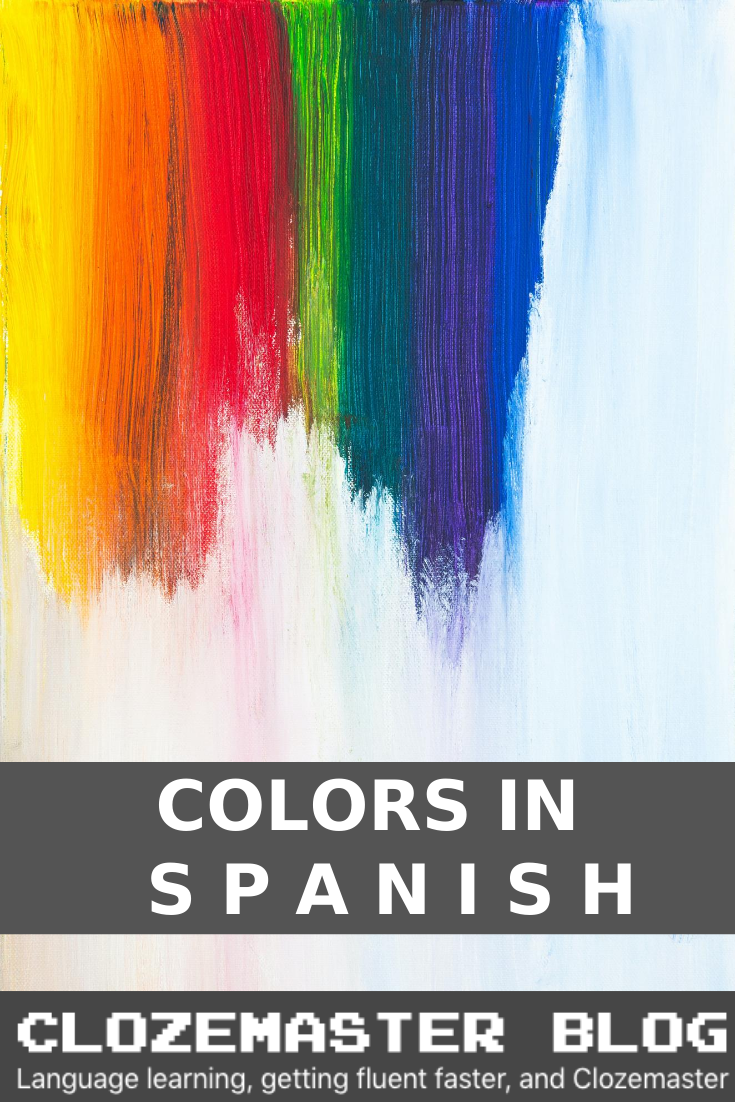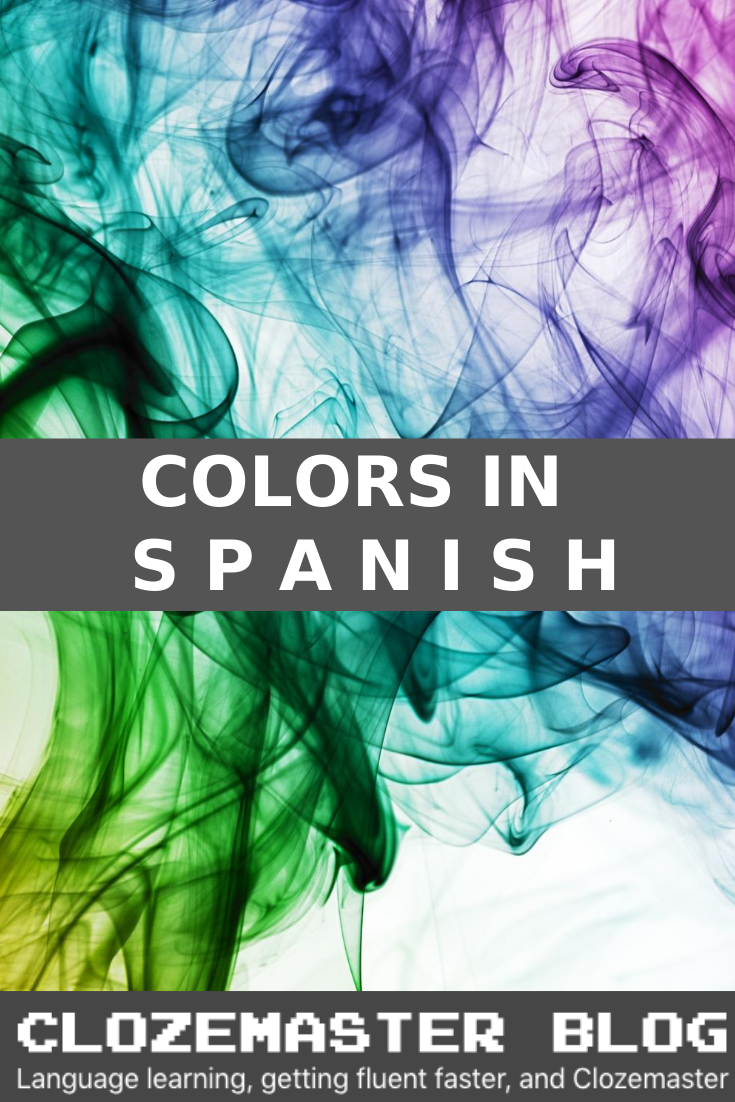
The Spanish colors, los colores, are pretty important words used in everyday life. You’ll need them to describe just about anything, including yourself. Do you know all the color words, words to describe colors, as well as how to use them in a sentence? This post will make sure you are a Spanish colors expert!
So let’s get started in making your Spanish vocabulary more colorful!
The Spanish Colors | Los colores en español
The Spanish colors are as follows:
Primary Spanish colors | Los colores primarios
- Amarillo = Yellow
- Azul = Blue
- Rojo = Red
Secondary Spanish colors | Los colores secundarios
- Verde = Green
- Rosa/Rosado = Pink
- Naranja/naranjado = Orange
- Morado/Violeta = Purple
- Marrón = Brown
Spanish shades | Los tonos
- Blanco = White
- Negro = Black
- Gris = Gray
The Origins of the Spanish Color Words
While a lot of words in Spanish look very similar to their English counterparts, you might have noticed that the colors all look quite different. This is because the English colors mostly come from Germanic roots, whereas the Spanish ones generally originate from Latin or Arabic. Let’s have a look at the origin and meaning of the Spanish colors in a bit more detail.
Spanish colors that come from Latin:
- Rojo (red) – comes from “Russus”
- Amarillo (yellow) – comes from “Amarellus” which roots back to the meaning amargo or sour.
- Verde (green) – comes from “Viridus” which links back to meanings of youth and life
- Negro (black) – from “Niger” meaning “brilliant black”
- Morado (purple) – from “morum” meaning blackberry (which is mora in Spanish).
- Rosa/do (pink) – from “rosatus” which means “of roses”
Spanish colors that come from Arabic:
- Naranja (orange) – comes from Persian originally, but was introduced to Spanish via Arabic. The name referred to the person responsible for looking after fruits, including oranges.
- Azul (blue) – comes from the precious blue stone “lazawardy”. Again, the word was originally taken from Persian but entered Spanish through contact with Arabic
Spanish colors that come From Germanic roots:
- Blanco (white) – comes from the German word “blank” meaning bare or blank. This was originally a word used to describe the whitest horses.
- Gris (gray) – comes from a Germanic word meaning metallic.
Spanish colors that come from French:
- Violeta (purple) – from “violette”, meaning violet flower
- Marrón (brown) – from “marron”
How to Use Spanish Colors in a Sentence
Spanish colors are used the same way as any Spanish adjectives. How to use adjectives in sentences in different ways is explained in this post (and it also includes quite a few examples with colors).
Using ser/estar with colors
You will see and hear a lot of colors being used in sentences with both ser and estar. So which one is correct?
Both can be used, but the meaning is different. If you use ser, you mean that the object you are describing is always this color. If you use estar, you are talking about a temporary color, which has normally been caused by some event.
Spanish colors that don’t change form
You may have noticed above that there is more than one word for some colors. In some dialects of Spanish, the words naranja and rosa are used as adjectives for colors. Because they come directly from nouns (orange and rose), they do not change their forms when used in sentences as adjectives. Although sometimes you may see them in plural form, you would never see the ending change from an a to an o, even if the noun is masculine.
However, it is increasingly common to instead say anaranjado and rosado. In these forms, the words can then be treated as any old regular adjectives.

Describing Colors
Sometimes, just the color isn’t enough of a detailed description. Often we need to describe a color further to be more specific and make it clearer what we are talking about.
Some words you can use instead of specific colors are:
- Colorido = colorful
- Monótono = monotone
The words to describe colors are:
- Brillante = bright
- Oscuro = dark
- Claro = light
- Transparente = transparent, see-through
- Opaco = opaque
- Pastel = pastel
- Apagado = dull
- Marino = navy (usually only used with blue)
These words can be used when the color is an adjective and also when it is used as a noun.
For example:
- El oceano era un azul marino. | The ocean was a navy blue.
- Compré un vestido amarillo pastel. | I bought a pastel pink dress.
- El árbol de navidad iluminaba de rojo y verde brillante. | The Christmas tree shone red and bright green.
- Me gusta el rosado claro. | I like light pink.
How to Talk about Your Favorite Color in Spanish
Another time you may want to talk about Spanish colors is when talking about favorite colors.
“Favorite” in Spanish is translated as either favorito or preferido. So you can say:
- Cuál es tu color favorito/preferido? | What is your favorite color?
- Mi color favorito/preferido es el… | My favorite color is…
In this kind of general color discussions, colors will always be masculine and singular.
Other sentences to talk about your opinions on colors can be:
- (No) me gusta el…. | I don’t like…
- Prefiero el… | I prefer…
- Me encanta el… | I love…
- Odio el… | I hate…
Using Spanish Colors to Describe People
When you want to describe the color of someone’s features in Spanish, you have to be a bit careful as the vocabulary is not all exactly the same as for regular colors. Just like in English, where we have different words for hair colors, such as blonde, brunette, and ginger, Spanish also uses different words for some hair, eye and skin colors.
Hair colors in Spanish | Los colores del pelo/cabello
- Rubio/Mono = blonde
- Castaño = brunette
- Pelirrojo = ginger
- Negro = black
Skin colors in Spanish | Los colores de la piel
- Blanco = white
- Moreno = brown
- Negro = black
- Oliva = olive/oriental
Eye colors in Spanish | Los colores de los ojos
- Azules = blue
- Verdes = green
- Marrones/Castaños = brown
- Negros = black
- Avellana = hazel
How to talk about colors of physical features in Spanish
To use these personal describing colors in Spanish, you generally use the following formula, which is literally saying what you have:
(pronoun/name) + tener (conjugated) + article + body part + color
Note: make sure the color agrees in gender and number with the body part noun!
For example:
- Tengo el pelo rubio. | I have blonde hair.
- Él tiene la piel blanca. | He has white skin.
- Mis hermanas tienen los ojos avellana. | My sisters have hazel eyes.
Note that the adjective avellana is the same as rosa and naranja (mentioned above) in that it does not change form because it comes directly from a noun – in this case, avellana means hazelnut.
For hair and skin color, you can also say what you are, using the following formula:
(pronoun/name) + ser (conjugated) + hair/skin color
In this case, the hair or skin color word must agree in gender and number with the person/people you are describing!
For example:
- Soy negro. | I am black. (male)
- Nosotros somos rubias. | We are blonde. (females)
- Mis abuelos paternales son morenos. | My paternal grandparents are brown.
- María es pelirroja. | Maria is ginger.
If you have learned something about Spanish colors today or found some new vocabulary related to the colors, then this post has served its purpose. If you want to use colors in an even more natural way, this Lingoda post has some great Spanish idioms that include color words.
Don’t forget to use Clozemaster to keep increasing your Spanish vocabulary and making sure those new words stick!
Challenge yourself with Clozemaster
Test your skills and see what you’ve learned from this article by playing a selection of sentences with Spanish color names.
Sign up here to save your progress and start getting fluent with thousands of Spanish sentences at Clozemaster.
Clozemaster has been designed to help you learn the language in context by filling in the gaps in authentic sentences. With features such as Grammar Challenges, Cloze-Listening, and Cloze-Reading, the app will let you emphasize all the competencies necessary to become fluent in Spanish.
Take your Spanish to the next level. Click here to start practicing with real Spanish sentences!



This place is real fun its nice to know how to learn how to speak spanish thanks for whoever created this site.
Nice post mate, I’m currently thinking on taking some spanish courses barcelona is my dream city to travel, and I wanna feel comfortable about the language before I go there